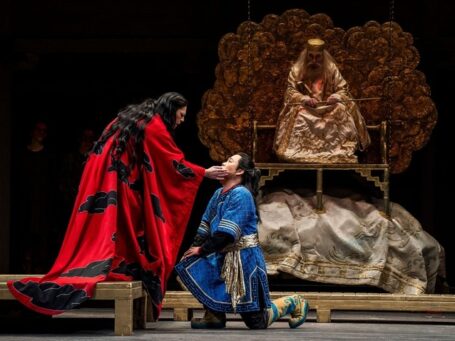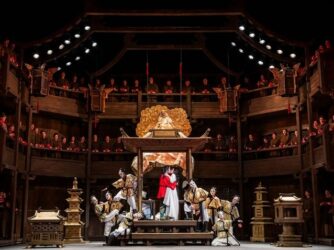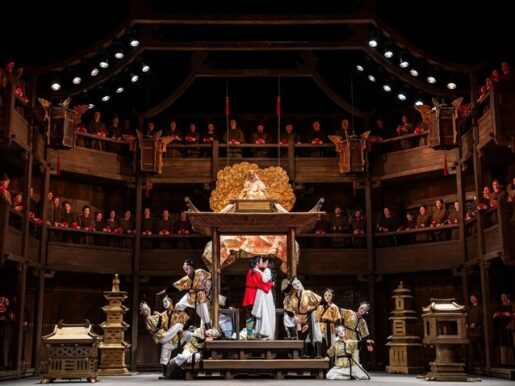 United Kingdom Puccini, Turandot: Soloists, Royal Opera Chorus and Orchestra of the Royal Opera House / Rafael Payare (conductor). Broadcast live (directed by Bridget Caldwell) from the Royal Opera House, Covent Garden, to Cineworld Basildon, Essex, 1.4.2025. (JPr)
United Kingdom Puccini, Turandot: Soloists, Royal Opera Chorus and Orchestra of the Royal Opera House / Rafael Payare (conductor). Broadcast live (directed by Bridget Caldwell) from the Royal Opera House, Covent Garden, to Cineworld Basildon, Essex, 1.4.2025. (JPr)

In reviewing this broadcast I will begin by recounting (once again) my historical connection to Puccini’s opera as I knew Dame Eva Turner, one of the first Turandots (or Turandohs as she always pronounced it), as well as, Dame Gwyneth Jones; and often they talked about the demands of this fiendishly difficult role. Dame Eva was at the premiere of the opera in 1926 and first sang the role only a few months later: whilst Dame Gwyneth sang Turandot in the Los Angeles premiere of Andrei Serban’s production at the 1984 Olympics Arts Festival that commissioned it.
Jack Furness has once again revived Serban’s Tai chi-inspired production in its designs by Sally Jacobs and with Kate Flatt’s choreography. When I saw Turandot during its opening month at Covent Garden (September 1984) it was its 137th time at the Royal Opera House, and now it has reached 299 thanks to umpteen subsequent revivals in the intervening four decades (and it will return again next season with Anna Netrebko as one of the Turandots)! This famous staging which has toured the world came about when both the original production team and their replacements were fired with the commission ending up with Jacobs, Flatt and Serban who are believed to have had only six weeks to get it to the stage. Apparently, we owe the prominence of all the dancers (and actors) to the lack of time for staging the enormous chorus and that also resulted in Jacobs having them sing from tiered, drum-shaped balconies. This also helps create something of a soundbox which throws the voices out into the auditorium.
Much of the mise en scène is more familiar now than in 1984 from countless scenes of Chinese New Year celebrations, travel documentaries and movies originating in China. Familiarity can breed contempt, and though its replacement had been expected by now, Serban’s Turandot is back again refurbished – or so it seemed to me. Perhaps, ‘if it ain’t broke don’t fix it’, especially with an opera as problematical as Turandot. Serban strives for some authenticity with its Chinese masks, costumes, pageantry, ceremonial dance and bloodthirsty savagery. The long red ribbons at the beginning, the single, two-tiered set for the brown robed chorus, and the dramatic masks of Turandot’s beheaded suitors with stylised silken blood, all look as vibrant as it must have done during those first 1984 performances.
Apart from some processions, some ceremonial dancing and the high jinks of the three ministers, Ping, Pang and Pong, very little actually happens. The leading characters, Calaf, Turandot, Liù and Timur, just walk on, around each other, or off, as appropriate. They always seem rather one-dimensional and perhaps this was part of the problem Puccini had in finishing Turandot. Not even Plácido Domingo or Gwyneth Jones made anything of them in Los Angeles in July 1984, I understand; nor did Ernesto Veronelli and the late Ghena Dimitrova who I saw at Covent Garden a couple of months later.
An 1802 play by Friedrich Schiller about a cold princess Turandot is believed to have inspired Puccini’s opera particularly because she was very different to his other principal female characters who were often doomed to suffer and sometimes die for love. The composer was particularly taken by ‘The Unknown Prince’ Calaf’s ‘journey’ and how he ends the opera. In addition, he wanted from Adami and Simoni, his librettists, a wide variety of characters: Ping, Pang and Pong provide some light comic, albeit heavily ironic, relief and the doomed slave girl Liù (who is not in the original Carlo Gozzi source material) was created to counterbalance the princess’s character. Finally, there are possible autobiographical elements: is Calaf Puccini himself, is Turandot his wife Elvira and is Liù the tragic Doria Manfredi of the infamous scandal?
The writing and composition of Turandot proved troublesome and took almost five years. The orchestration was nearly complete and only the final duet after Liù’s death was missing on Puccini’s early death in 1924. Puccini’s music for Turandot is in many respects his most advanced and most modern in style. He sought out real Chinese music to imitate and his two sources for this were a music box owned by a friend, and Chinese Music, a booklet by J.A. van Aalst, published in Shanghai in 1884: Puccini incorporates several traditional Chinese melodies in Turandot.
It is one of the most complex and original scores of the twentieth century. Every detail was illuminated by Rafael Payare’s exuberant conducting which perfectly blended brash dissonances with textural power and thrilling climaxes, but also allowed for some very refined, almost chamber-like orchestral moments when you think you are hearing things you missed before. Payare certainly brought into sharp focus where Puccini’s invention ‘died’ and Alfano – with input from Arturo Toscanini – took over to complete the dramatically implausible concluding pages. From the pathos of the funeral for Liù – after her sacrifice for her beloved Calaf – it is downhill all the way to the incandescence of the love-triumphant chorus (‘O sole! Vita! Eternità’) at the very end. For their concluding duet Puccini wrote on the sketches ‘Poi Tristano’ (‘Then, Tristan’) and Alfano/Toscanini leave us with only hints at what might have been had the composer lived to finish his opera. The Royal Opera House Orchestra sounded – through cinema loudspeakers – as it they were at their very best for Payare; and the significantly enlarged Royal Opera Chorus were their usual dependable selves and sang out with strength and power. Together with the orchestra this provided a rich dramatic background for the soloists.

Most people regard Calaf as something of an ‘emotionless bastard’ because he is willing to let Liù die so that he can continue to climb the social ladder. As such SeokJong Baek somewhat subdued, unshowy performance befitted this perception, and it was a surprise when Baek smiled for the one and only time when embracing Turandot during the opera’s final pages. Baek’s voice is not especially Italianate but is solid throughout its range and the highpoint of his performance was an assuredly ardent, ‘Nessun dorma’, even if he held on to his climactic high B so long that Payare had already moved the music on – to avoid interruptive applause – before he had finished.
Up-and-coming British soprano Gemma Summerfield sang Liù early (she is in the second cast) replacing the indisposed Anna Princeva. She is clearly a soprano to look out for; Summerfield sang radiantly after a slightly uncertain start and a touch of steel suggested she might be a Turandot of the future herself. ‘Signore, ascolta’ and ‘Tu che di gel sei cinto’ drew the audience (in the theatre and at the cinema) into her character’s plight and Summerfield sang with great feeling. Jette Parker Young Artist Ossian Huskinson impressed as an authoritative Mandarin. Adam Palka was Timur, sadly, I have nothing good to say about his singing and hope it was just an off night, whilst Hansung Yoo (Ping), Aled Hall (Pang) and Michael Gibson (Pong) were a hyperactive, frequently acrobatic, well-sung trio. Paul Hopwood – described in his own bio as ‘probably one of the busier singers of whom you have never heard’ – was a suitably venerable-sounding Emperor.
Finally, Turandot herself. Sondra Radvanovsky appeared – to me at least – to only go through the motions (gestures?) of Serban’s original idea for the character because she had her own thoughts about her. We heard in an interval film how for Radvanovsky Turandot is the opposite of an ‘ice princess’: ‘She wants to be loved, and I think it’s all right there in the music … when I come back to this opera I always have some questions. Where’s her mother? … we see her dad, but we never hear mention of her mother.’ Radvanovsky wondered whether she suffered the same fate as her ancestor Lo-u-Ling who was brutally killed by a foreign prince (we hear this in ‘O questa reggia’), ‘I wonder if that was passed down from generation to generation, therefore she did not know any other way except to be this cold “ice princess” that they call her, but I think after so many years of that you see this woman who all she really wants is to be loved.’
That – and at odds with Serban – is how Radvanovsky portrayed Turandot, constantly reaching out the try and touch Calaf, and as they finally touched hands during their final duet it created quite a frisson before at last they kissed. This was totally different to when the late Franco Bonisolli leapt upon Gwyneth Jones’s Turandot at the same point in this production in 1988, apparently to her great surprise! Radvanovsky’s loud voice was warmer and less typically laser-like; a mature dramatic soprano sound that was perfectly suited to her concept of a more-human Turandot. Musically accurate (as you come to expect from Radvanovsky) and every nuance of her words mattered, and as a result all Turandot’s pronouncements were suitably imperious.
Jim Pritchard
Creatives:
Director – Andrei Șerban
Revival director – Jack Furness
Designer – Sally Jacobs
Lighting designer – F. Mitchell Dana
Choreographer – Kate Flatt
Choreologist – Tatiana Novaes Coelho
Chorus director – William Spaulding
Cast:
Princess Turandot – Sondra Radvanovsky
Calaf – SeokJong Baek
Liù – Gemma Summerfield
Timur – Adam Palka
Ping – Hansung Yoo
Pang – Aled Hall
Pong – Michael Gibson
Emperor Altoum – Paul Hopwood
Mandarin – Ossian Huskinson
Soprano Solos – Marianne Cotterill, Tamsin Coombs

I saw this production on Tuesday April 1st, and haven’t stopped thinking about it since. So spectacular. SeokJong Baek made a wonderful Calaf, so solid and secure vocally and Gemma Summerfield was such a great Liu, I think she would have made a better Turandot quite honestly, she was believable and the audience were right behind her. I have to agree with the comment about Timur, whose diction was non-existent. Loved the three ministers, Ping, Pang and Pong, who brought some much-needed light relief and sang so well together. The scenery and staging were amazing and the Orchestra, as always, a delight. One wish …please get Ms Radvanovsky a better wig and lighter make-up, it made her look old and haggard, and she really isn’t!!!!
Who decided that Turandot would now and again be drawn to almost touch Calaf, to be attracted, to be interested? Was it only Ms Radvanovsky? Whoever, I liked it. It made the ultimate melt more credible.
The red lipstick was indeed a bit harsh compared to the pretty pink which she wore when she was talking about the role, but it had to match the fabulous cloud gown!
Dare I be frivolous? I loved the boy’s boots!